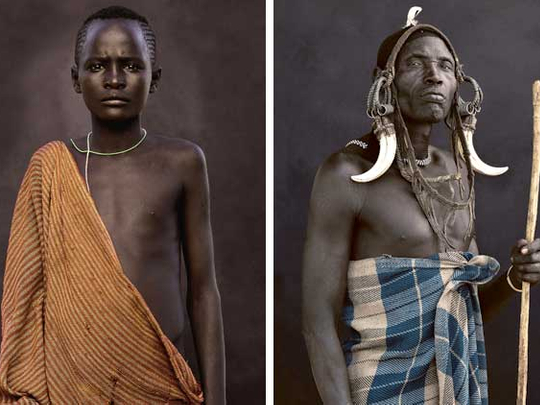
The origin of human beings has been traced to Africa, a continent blessed with great natural beauty and home to various tribes who have for centuries lived in harmony with their surroundings. But in a globalised world, the environment and the way of life of the people are being threatened by technological advancement and consumerism in society, which has resulted in Africa becoming the dumping ground for toxic electronic waste from around the world.
“Africa: From Mother to Motherboard”, a joint show by renowned Germany-based photojournalists Mario Marino and Kai Loffelbein, draws attention to this grave situation. Marino’s photographs from his “Faces of Africa” series feature stunning portraits of some of the most ancient tribes in Africa, subtly highlighting a fast disappearing way of life. And Loffelbein’s thought-provoking pictures from his documentary project “Kids of Sodom and Gomorrah” follow the trail of toxic electronic waste dumped by Western countries in Africa.
Both artists compel viewers to reflect on their own way of life and the consequences of their actions on other people in our highly interconnected world.
Marino, who was born in Austria, has been travelling around the world photographing various peoples in their native lands. The photographs in this show were taken in the Omo River Valley in Ethiopia. “I love people and I am fascinated by their cultural background and identity. To me it is essential to show their beauty and dignity. In 2001, I read an article in the newspaper about the discovery of the oldest human skull in the Omo valley, and became curious to visit this region to which all human beings can trace their roots. I spent two weeks there getting to know the seven indigenous tribes from the area and wandered with my mobile studio taking pictures of the people in market places and village squares. I call my portraits ‘photographic psychograms’ because I focus on showing the personality of the people along with their cultural background, and try to go beyond the faces to look at what is going on inside,” he says.
His images include portraits of smiling children, intense young men and women, a blind mother with her children, veiled Muslim women, and wise old men. The flora and fauna painted on their faces and bodies; the flowers, fruits and shells they wear as ornaments; and the textures and colours of their hand-woven garments speak about their close relationship with nature. Whereas, the sticks carried by the older men and the Kalashnikov rifles in the hands of the younger men, highlight the changes happening in this traditional society.
Marino’s lens goes beyond their proud demeanour and smiling faces to reveal the concern in their eyes as they contemplate an uncertain future. “These people have lived in harmony with nature for centuries. The patterns on their bodies, which distinguish one tribe from another, reflect this and are an important part of their identity. But their heritage is now being threatened by tourism, social globalisation and technological advancement such as a new dam being constructed on the Omo River, which will force them to leave their land,” he says.
Loffelbein’s project was also inspired by a newspaper report about electronic waste being illegally shipped to Africa. The German photographer followed the toxic trail from a port in his country to the recycling yards in Ghana, revealing the ugly reality with his stark images of young boys working in junkyards with no protective gear or proper tools, and scrap dealers who make a good living from this illegal and harmful waste. His images of the circuitry in motherboards from junked computers are a poetic reference to the tragic destruction of the continent where human beings originated.
“I am interested in subjects that play out in foreign countries but have a connection with my country. And this was a perfect example. Studies indicate that almost 50 per cent of the over 50 million tonnes of electronic waste generated annually is illegally shipped to developing countries. For example, Germany exports upto 100,000 tonnes of electronic waste every year. To circumvent the Basel Convention and other controls in the European Union, this waste is declared as second-hand goods or even development aid. But most of it ends up in landfills in countries such as Ghana,” Loffelbein says.
The artist was shocked with what he saw in Ghana’s capital, Accra. “The biggest e-waste dumping ground, Agbogbloshie, nicknamed ‘Sodom and Gomorroah’ by the locals is right in the middle of the city. And there were children and young boys dismantling computers, mobile phones and other devices by hand and burning them to extract valuable metals. The noxious fumes and chemicals they inhaled caused headaches, dizziness, skin ailments and nerve damage, besides contaminating the soil with toxic residue.
“Ideally, materials such as gold, silver and palladium should be recycled from this waste in industrialised countries. And technically the Ghanaian government should ban the import of such waste. But that does not happen because recycling is expensive and the scrap trade is very lucrative. Through these pictures I want to highlight the fact that those who create the problem must take the responsibility for sustainable disposable practices. But I also want to point out that as consumers we are all part of this problem, and we should all think about our actions and their consequences. I am committed to ‘concerned photography’ which aims not only at drawing people’s attention to various social problems, but also to make us all realise our own responsibility in a globalised world,” he says.
Jyoti Kalsi is an arts enthusiast based in Dubai
Africa: From Mother to Motherboard will run at The Empty Quarter, DIFC until January 23.













